My girls were attending a 5-day Irish dance workshop in Charlotte all last week, and on Thursday I took a vacation day to carpool them and a couple of other dancers down to the Queen City.
Of course I took the opportunity to indulge in a little architectural photo tourism while they were learning new steps. I started in Dilworth, one of Charlotte's beautiful historic districts. As you can see from this photo, it's pretty close to downtown.
 Dilworth is pretty big and I didn't have much time, so my photos probably aren't representative of the neighborhood as a whole. Most of the houses I saw (on and around Kingston St.) were quite modest.
Dilworth is pretty big and I didn't have much time, so my photos probably aren't representative of the neighborhood as a whole. Most of the houses I saw (on and around Kingston St.) were quite modest.
I particularly liked the pattern of shingles on this bungalow, which I haven't seen in Greensboro: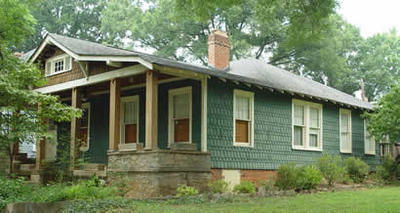 Some smart person a long time ago decided that utility lines in Dilworth should be strung in the alley right-of-ways behind the houses, which allows the growth of canopy trees between the street and sidewalk.
Some smart person a long time ago decided that utility lines in Dilworth should be strung in the alley right-of-ways behind the houses, which allows the growth of canopy trees between the street and sidewalk.
Even though the temperature was in the 90s, I was kept reasonably cool and comfortable walking the neighborhood because of that person's foresight. (Unfortunately this is not the arrangement through much of Greensboro's historic districts.)
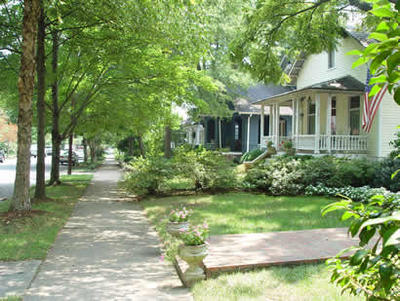 Dilworth seems to be attracting quite a bit of investment. For example, much of what you see in the picture below is an addition (garage and second story) to a craftsman bunglalow. One of the workmen I talked to indicated that the owner had at first wanted to tear down the original building, but "those historical people wouldn't let him."
Dilworth seems to be attracting quite a bit of investment. For example, much of what you see in the picture below is an addition (garage and second story) to a craftsman bunglalow. One of the workmen I talked to indicated that the owner had at first wanted to tear down the original building, but "those historical people wouldn't let him." Those darn historical people!
Those darn historical people!
This section of Dilworth also had some really nice, old, multifamily buildings mixed in with the single-family houses: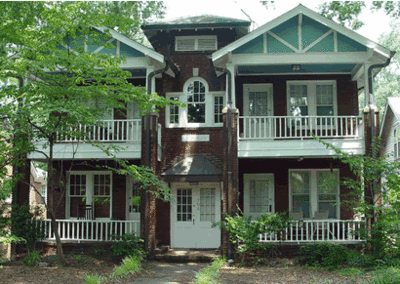
And this Queen-Anne style house doubles as a law office; it wasn't unusual even when these neighborhoods were new for people to use their houses as "live-work" units. Despite the mix of rental, business, and owner-occupied dwellings, real estate values were quite high. This fully renovated, 3,000 sq. ft. foursquare is for sale at an asking price of $905,000.
Despite the mix of rental, business, and owner-occupied dwellings, real estate values were quite high. This fully renovated, 3,000 sq. ft. foursquare is for sale at an asking price of $905,000.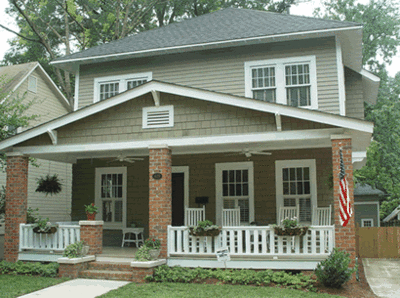 That's a price that would be envied even in Fisher Park, the priciest of Greensboro's historic districts.
That's a price that would be envied even in Fisher Park, the priciest of Greensboro's historic districts.
One of the things that makes Dilworth really livable is the nearness of shopping and recreation. You can easily walk to these shops and restaurants (some of my fellow preservationists might gag at the way these houses have been altered for commercial purposes -- but I think they did a good job of "adaptive re-use" here):
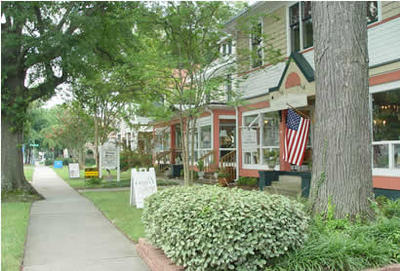 Or you can just as easily walk to the huge and beautiful Latta Park and cool off in the fountain:
Or you can just as easily walk to the huge and beautiful Latta Park and cool off in the fountain:
 I doubt whether all this just happened by accident. Dilworth is a good place because of some very good planning in the early 20th century.
I doubt whether all this just happened by accident. Dilworth is a good place because of some very good planning in the early 20th century.
And it's clear that planning is still going on. Where Dilworth runs into South Boulevard, you can see that Charlotte is working hard to integrate the new with the old. Lots of street construction is happening, and it apeared to me that the city is digging up South Boulevard's middle "suicide" lane to convert the street back to a true boulevard. That will make it not only more attractive, but a little more comfortable for Dilworth's pedestrians to cross.
New commercial construction on South boulevard seems to conform to a "pedestrian scale" design standard that brings the buildings up to the sidewalk and puts parking in the rear. I wonder how hard it was for the city to persuade Office Depot to build this . . .

. . . instead of doing the standard cinder block box in a puddle of asphalt that is the design standard here in Greensboro.
A little further up South Boulevard stands this new and impressive building:

It's a combination of commercial space and conominiums (on the left). It's also a good example of a building "wrap" that Ray Gibbs told me about, with a parking deck wrapped inside the domestic and business space. Here's what the deck looks like as it runs into the back of the condominiums: The deck really isn't visible from the street at all (you're looking at an alley). Another nice touch in this area is the inlaid signage that you can find at each intersection:
The deck really isn't visible from the street at all (you're looking at an alley). Another nice touch in this area is the inlaid signage that you can find at each intersection: All of these features taken together -- effective (and affectionate) preservation, attractive design standards, efforts to accomodate both pedestrians and cars -- speak to me of a city that understands, cherishes, and is committed to improving its urban environment.
All of these features taken together -- effective (and affectionate) preservation, attractive design standards, efforts to accomodate both pedestrians and cars -- speak to me of a city that understands, cherishes, and is committed to improving its urban environment.
Sigh.
4 comments:
Beautiful!
David, please keep planting these seeds of smart planning, development, and redevelopment.
Ditto.
David, what would you say to someone who objects to any smart planning because nicer neighborhoods make the property values rise so that only wealthier people can afford to live there?
I have heard this argument made; and when floored, it is difficult to come up with a rejoinder.
Anna, it sounds like your friend is advocating bad neighborhoods for poor people! I've heard slumlords make similar arguments -- "if I fix my units up, these poor people won't be able to afford them."
I would say two things to your friend. First, property values are partly determined by the law of supply and demand. If smart-growth neighborhoods show spikes in property values (and my limited experience indicates that they do), it's an indication that the demand for smart growth neighborhoods is far exceeding the supply. The remedy? Increase the supply. Keep building them, and market competition will bring real estate prices down.
Second, I would point to the Willow Oaks project here in Greensboro, and many other Hope VI projects across the country, which builds in low-income housing mixed with middle and upper-middle class.
Post a Comment